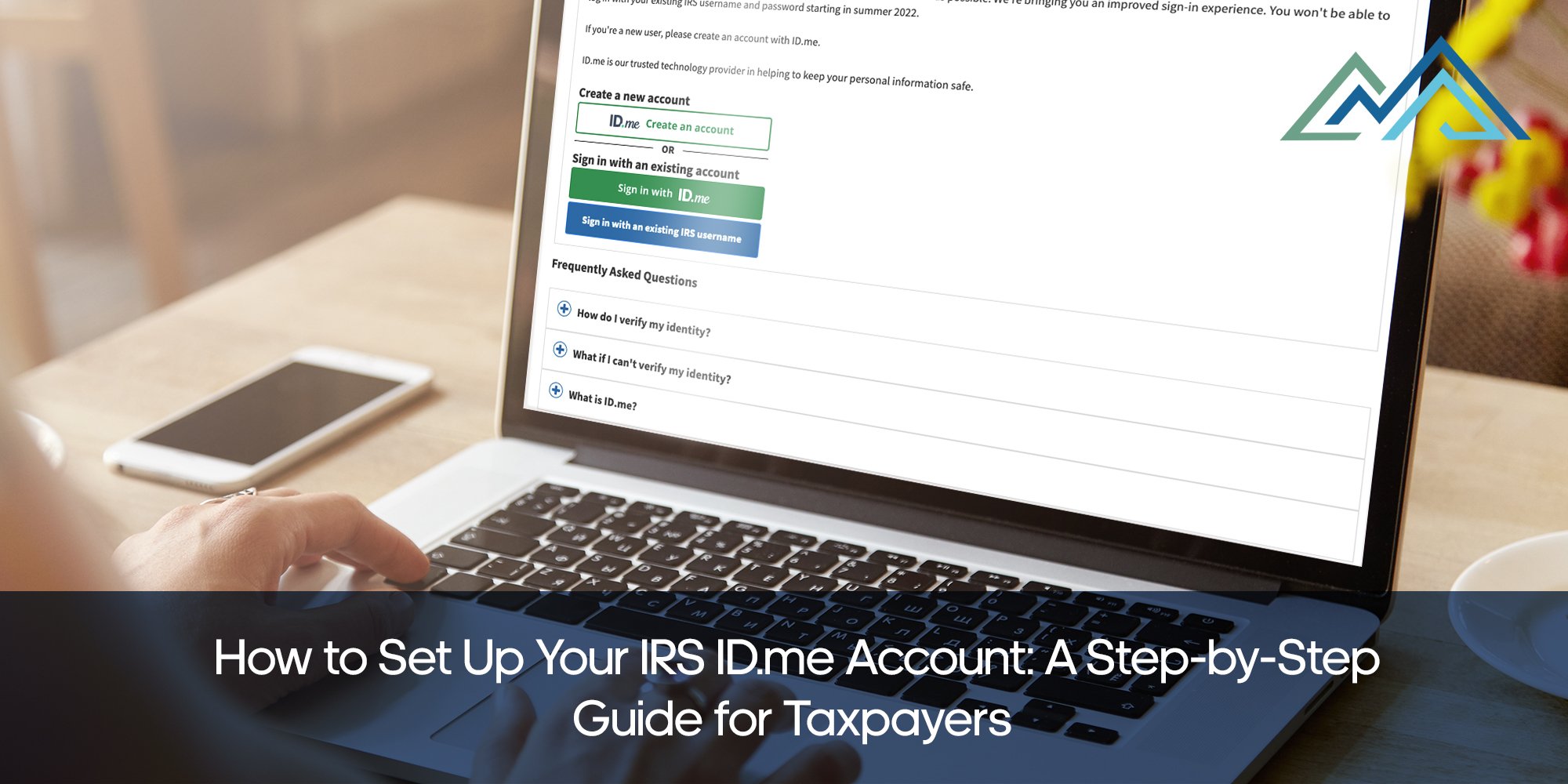The IRS has made a major shift: while paper tax refund checks and manual identity verification have long been staples of filing and refund processes, the agency is now pushing taxpayers toward a digital, identity-verified future using ID.me.
This change isn’t just a convenience; it’s a foundational shift in how taxpayers will access refunds, manage payments, authorize tax professionals, and interact with IRS services.
If you’re asking,
How do I create an ID.me account to access my IRS online services?
You’re in the right place.
To create an ID.me account for IRS online services, go to IRS.gov and select “Sign in with ID.me.” Enter your email, create a password, and verify your identity using a government-issued ID and a selfie or short video call.
Once verified, your ID.me account is connected to your IRS profile, providing secure access to tax records, payments, and refund information. This digital setup enhances security and streamlines the online tax management process.
Below, we’ll walk through exactly how to set one up securely and show how CMP can support your transition, so you stay ahead of deadlines and avoid disruptions.

What’s Changing at the IRS
Phasing out paper checks.
Beginning September 30, 2025, the U.S. Department of the Treasury and, by extension, the IRS, will ceased issuing paper checks for most federal payments and refunds, as mandated by Executive Order 14247. The IRS has confirmed that paper refund checks for individual taxpayers will be phased out starting that date.
Why the change?
- To modernize and streamline processing.
- To reduce costs (paper check processing is expensive).
- To reduce fraud, lost or stolen checks, and delays.
Which services are affected?
Refunds will no longer be mailed as paper checks (except in rare, legally authorized exception cases) as of Sept. 30, 2025. The IRS also indicates that tax payments will increasingly move to electronic formats, such as direct deposit, EFTPS, etc.
Taxpayers must prepare: if you normally receive a mailed refund, you’ll need to provide valid banking information or choose an alternate digital payment method by that deadline to avoid disruption.
It’s also worth noting that the IRS is expanding digital, paperless processing of non-tax forms and services as part of its modernization efforts.
Why ID.me Matters
What is ID.me?
ID.me is a digital identity verification provider that the IRS and other government agencies use to securely confirm a user’s identity before granting access to online services. When a user logs into an IRS tool (e.g., “Get Transcript”), they are routed through ID.me’s verification process.
Why the IRS uses it
- To reduce identity fraud.
- To ensure only the rightful taxpayer (or their authorized agent) can access sensitive data.
- To streamline access to IRS online accounts while maintaining strong security.
Addressing privacy and security concerns
- The IRS has recently reduced or eliminated facial recognition. requirements and added non-biometric verification options to respond to public privacy concerns.
- ID.me uses multi-factor authentication (MFA) to add an extra security layer.
- Only limited identity data is shared to authorize access. ID.me and the IRS adhere to strict data protection and privacy rules.
- If verification fails, users are given alternative methods or direct support paths.
In short, ID.me helps ensure only legitimate users access IRS tools, while enabling the IRS’s shift to more efficient, secure digital services.
How to Create and Verify Your ID.me Account (Step-by-Step)
Below is a practical walkthrough. Before you begin, gather the following:
What you’ll need:
- A valid identity document (driver’s license, state ID, passport).
- Your Social Security number.
- A smartphone or device capable of taking photos or video (camera).
- A working email address.
Step-by-step setup:
Visit the IRS Online tool or “Get Transcript / Online Account” page
- Visit IRS.gov and choose the service you want to access, such as “Get Transcript Online” or “IRS Online Account.”.
- This avoids confusion and aligns with IRS UX phrasing.
Create an ID.me account (if you don’t already have one)
- Click on the option to Create an Account.
- Enter your email, set a password, and complete basic registration.
Enable Multi-Factor Authentication (MFA / 2FA)
- As part of setup, you'll need to enroll in MFA (for example, via text message, authenticator app, or alternate method) to protect your account.
Verify your identity
- Upload a photo of your identity document (driver’s license, passport, state ID).
- Depending on the verification path, you may be asked to take a “selfie” or video to match the identity document.
- In some cases, a live video interview (with an agent) might be required rather than relying solely on biometrics.
Link ID.me to your IRS Online Account
- Once ID.me verification is complete, you’ll be redirected to connect it with the IRS tool/service you were accessing.
- Grant consent for ID.me to share identity data with the IRS so your session can be authenticated by entering your SSN.
Access IRS services
- After linking, you log in via ID.me and are taken into your IRS online portal.
- If you already have an IRS Online Account, your profiles will be merged/connected.
What You Can Access with Your ID.me-Verified IRS Account
Once your IRS account is verified through ID.me, you can securely access and manage key tax services online, including:
- View refund and payment status: Track your refund, review payment history, and confirm upcoming payments.
- Set up or change direct deposit details: Manage bank information to receive refunds electronically.
- Access tax transcripts: Download or view wage, account, and return transcripts instantly.
- Request or manage your Identity Protection PIN (IP PIN): Protect your tax account from fraudulent filings.
- Authorize a tax professional: Grant Power of Attorney (POA) for your accountant or preparer to access your account.
- Manage notices and communications: Receive certain IRS notices electronically and update your delivery preferences.
- Use additional IRS tools: Access identity verification and protection services that require a verified login.
This shift means less reliance on mailing or snail-mail processes; more of your interactions and access will be direct, secure, and in real time (or near real time).
Why This Change Benefits Taxpayers
- Faster refunds and fewer delays: Digital disbursements are processed quickly with no risk of lost or delayed checks.
- Stronger identity protection: ID.me’s verification and multi-factor authentication significantly reduce fraud risk.
- Simplified collaboration with tax professionals: Authorized accountants and agents can securely access your account without exchanging physical documents.
- 24/7 access to IRS tools: Manage your taxes anytime, anywhere, through a secure online account.
- Easier banking updates: Change or update your bank account information to receive refunds via direct deposit.
Overall, this shift reflects the federal government’s broader modernization effort to move essential services online, improving security, speed, and accessibility for taxpayers nationwide.
If You Encounter Issues: Troubleshooting and Fallback Options
If verification fails:
- Retry the process — lighting or document clarity can cause rejections.
- Use alternative verification options (non-biometric or live-video).
- Visit the ID.me Help Center or use the IRS “What if I can’t verify my identity?” links.
If you lack the required technology or ID:
- Contact the IRS or ID.me to request alternative identity proof.
- Ask about in-person or paper-based verification (if available).
If you don’t have banking access:
- The Department of the Treasury allows limited exceptions for non-electronic refunds in specific hardship or accessibility cases.
Frequently Asked Questions
Below are some quick answers to help you understand how verification works, what changes are coming, and how they affect your access to IRS services.
Why is the IRS encouraging taxpayers to use ID.me?
To protect taxpayer accounts through verified digital identity and reduce fraud. It’s part of the IRS’s modernization effort to make online tax services faster, more secure, and easier to access.
Can I still receive a paper check from the IRS after 2025?
No. Beginning September 30, 2025, paper refund checks will be phased out under Executive Order 14247. Only limited hardship exceptions will allow non-electronic refunds.
Is ID.me safe, and how does it protect my data?
Yes. ID.me uses encryption, multi-factor authentication, and strict privacy controls. It shares only necessary information with the IRS and has reduced reliance on biometric verification.
Can my accountant access my IRS account through ID.me?
Yes. Once verified, you can authorize your accountant or preparer through a Power of Attorney (POA) to securely access your IRS account and manage filings on your behalf.
What if I fail the ID.me verification process?
Retry with clearer photos or better lighting, use a live-video option, or contact ID.me or the IRS. You may also verify in person at an IRS Taxpayer Assistance Center.
What IRS services can I access after verification?
You can check refund status, manage direct deposits, view transcripts, request an IP PIN, grant POA access, and use secure IRS tools online.
Let CMP Help You Navigate the IRS Digital Transition
The upcoming transition represents a significant and unavoidable shift in how taxpayers interact with the IRS. CMP stands ready to help your business or clientele adapt seamlessly. We can:
- Walk you through ID.me setup and verification
- Help ensure banking and refund information is correctly configured before the 2025 deadline
- Train staff and clients on secure login and multi-factor authentication
- Troubleshoot verification problems, fallback options, and appeals
Don’t wait until the next tax season to scramble. Contact us today, and we’ll guide you step by step to a smooth, secure, and compliant transition to the IRS’s new digital identity paradigm.

















